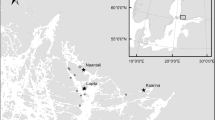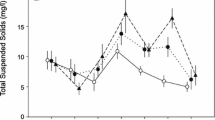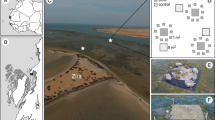Abstract
The Mondego Estuary (Portugal) underwent major modifications in the late 1980s, because of eutrophication, for which it was developed a restoration programme that has been effective in recovering seagrass beds. Recently, this system has been affected by successive weather extremes: floods, droughts, and heat waves. The effect of these multiple stressors on a Cyathura carinata (Isopoda) population has been evaluated, through a long-term data series (16 years) in a seagrass bed, an intermediate area, and a sand flat. A well age-structured and abundant population of C. carinata was observed in the sand flat, in contrast with the seagrass bed and intermediate area. After introducing the restoration measures, C. carinata’s abundance increased even in the stations where it was formerly scarce. This recovery was compromised by successive extreme events. C. carinata declined severely in terms of total abundance and growth production during the 2003 summer heat wave, at the sand flat, also endangering its reproductive success. Floods and droughts affected dispersion of the individuals, which was reflected in the population’s density and production. Nevertheless, this isopod had great resilience, recovering successfully after disturbances. In contrast, the population of C. carinata had less resilience in the seagrass bed and intermediate area, being unable to recover after a succession of disturbances, which may threaten the success of this species in the system. Because the frequency and intensity of weather extremes are expected to continue to increase in a scenario of global climate change, their repercussions will affect such populations, which will have difficulty surviving. This will have severe implications on the functioning of the whole ecosystem.







Similar content being viewed by others
References
Adams, S. M., 2005. Assessing cause and effect of multiple stressors of marine systems. Marine Pollution Bulletin 51: 649–657.
Bamber, R. N., 1985. The autoecology of Cyathura carinata (Crustacea: Isopoda) in a cooling water discharge lagoon. Journal of the Marine Biological Association of the United Kingdom 65: 181–194.
Blanchet, H., X. de Mountaudouin, A. Lucas & P. Chardy, 2004. Heterogeneity of macrozoobenthic assemblages within a Zostera noltii seagrass bed: diversity, abundance, biomass and structuring factors. Estuarine Coastal and Shelf Science 61: 111–123.
Burbanck, W. D. & G. P. Burbanck, 1967. Parameters of interstitial waters collected by a new sampler from the biotopes of Cyathura polita (Isopoda) in six southeastern states. Chesapeake Science 8: 14–27.
Burbanck, W. D. & M. P. Burbanck, 1975. Growth of an transplanted population of the estuarine Cyathura polita (Crustacea:Isopoda), Cape Cod, Massachusetts. Verhandlungen Internationale Vereinigung für Theoretische und Angewandte Limnologie 19: 3001–3006.
Burbanck, W. D. & M. P. Burbanck, 1979. Cyathura (Arthropoda: Crustacea: Isopoda: Anthuridae). In Hart, C. W. Jr., & S. L. H. Fuller (eds), Pollution Ecology of Estuarine Invertebrates. Academic Press, New York: 293–323.
Cardoso, P. G., D. Raffaelli, A. I. Lillebø, T. Verdelhos & M. A. Pardal, 2008a. The impact of extreme flooding events and anthropogenic stressors on the macrobenthic communities’ dynamics. Estuarine, Coastal and Shelf Science 76: 553–565.
Cardoso, P. G., D. Raffaelli & M. A. Pardal, 2008b. The impact of extreme weather events on the seagrass Zostera noltii and related Hydrobia ulvae population. Marine Pollution Bulletin 56: 483–492.
Cardoso, P. G., S. Leston, T. F. Grilo, M. D. Bordalo, D. Crespo, D. Raffaelli & M. A. Pardal, 2010. Implications of nutrient decline in the seagrass ecosystem success. Marine Pollution Bulletin 60: 601–608.
Clarke, K. R. & R. N. Gorley, 2006. PRIMER v6: User Manual/Tutorial. PRIMER-E, Plymouth.
Clarke, K. R. & R. M. Warwick, 2001. Change in Marine Communities. An Approach to Statistical Analysis and Interpretation. Primer-E Ltd., Plymouth.
Dolbeth, M., P. G. Cardoso, S. M. Ferreira, T. Verdelhos, D. Raffaelli & M. A. Pardal, 2007. Anthropogenic and natural disturbance effects on a macrobenthic estuarine community over a 10-year period. Marine Pollution Bulletin 54: 576–585.
Eleftheriou, A. & A. McIntyre, 2005. Methods for the Study of Marine Benthos, 3rd ed. Blackwell Science, Oxford.
Elliot, M. & V. Quintino, 2007. The estuarine quality paradox, environmental homeostasis and the difficult of detecting anthropogenic stress in naturally stressed areas. Marine Pollution Bulletin 54: 640–645.
Ferreira, S. M., M. A. Pardal, A. I. Lillebø, P. G. Cardoso & J. C. Marques, 2004. Population dynamics of Cyathura carinata (Isopoda) in a eutrophic temperate estuary. Estuarine Coastal and Shelf Science 61: 669–677.
Ferreira, S. M., A. Brandão, A. Baeta, J. M. Neto, A. I. Lillebø, K. T. Jensen & M. A. Pardal, 2007. Effects of restoration management on the estuarine isopod Cyathura carinata: mediation by trematodes and habitat change. Marine Biology 151: 109–118.
Gaschütz, G., D. Pauly, & N. David, 1980. A versatile basic program for fitting weight and seasonally oscillating length growth data. ICES CM G24: 1–23.
Gayanillo, F. C. Jr., P. Sparre & D. Pauly, 2005. FAO-ICLARM Stock Assessment Tools II Revised Version, User’s Guide. Worldfish Center food and agriculture organization of the United Nations, Rome.
Harley, C. D. G., A. R. Hughes, K. M. Hultgren, B. G. Miner, C. J. B. Sorte, C. S. Thornber, L. F. Rodriguez, L. Tomanek & S. L. Williams, 2006. The impacts of climate change in coastal marine system. Ecology Letters 9: 228–241.
IPCC, 2007: Climate change 2007: Synthesis report. Contribution of Working Groups I, II and III to the Fourth Assessment Report of the Intergovernmental Panel on Climate. Change Core Writing Team, R. K. Pachauri & A. Reisinger (eds). IPCC, Geneva, Switzerland.
Jazdzewski, K., 1969. Biology of two hermaphroditic crustaceans, Cyathura carinata (Kröer) (Isopoda) and Heterotanais oerstedi (Kröer) (Tanaidacea) in waters of the polish Baltic Sea. Zoologica Poloniae 19: 5–25.
Jensen, K. T., S. M. Ferreira & M. A. Pardal, 2004. Trematodes in a Cyathura carinata population from a temperate intertidal estuary: infection patterns and impact on host. Journal of the Marine Biological Association of the United Kingdom 84: 1151–1158.
Lillebø, A. I., J. M. Neto, I. Martins, T. Verdelhos, S. Leston, P. G. Cardoso, S. M. Ferreira, J. C. Marques & M. A. Pardal, 2005. Management of a shallow temperate estuary to control eutrophication: the effect of hydrodynamics on the system’s nutrient loading. Estuarine, Coastal and Shelf Science 65: 697–707.
Martins, I., J. C. Marques, S. E. Jørgensen & S. N. Nielsen, 1997. Modelling the effects of green macroalgae blooms on the population dynamics of Cyathura carinata (Crustacea:Isopoda) in an eutrophied estuary. Ecological Modelling 102: 33–53.
McLusky, D. S. & M. Elliot, 2004. The Estuarine Ecosystem: Ecology, Threats and Management. Oxford University Press, Oxford.
Norkko, J., E. Bonsdorf & A. Norkko, 2000. Drifting algal mats as an alternative habitat for benthic invertebrates: species specific responses to a transient resource. Journal of Experimental Marine Biology and Ecology 248: 79–104.
Olafsson, E. B. & L.-E. Persson, 1986. Distribution, life cycle and demography in a brackish water population of the isopod Cyathura carinata (Kröyer) (Crustacea). Estuarine Coastal and Shelf Science 23: 673–687.
Pardal, M. A., P. G. Cardoso, J. P. Sousa, J. C. Marques & D. Raffaelli, 2004. Assessing environmental quality: a novel approach. Marine Ecology Progress Series 267: 1–8.
Roth, O., J. Kurtz & T. B. H. Reusch, 2010. A summer heat wave decreases the immunocompetence of the mesograzer, Idotea baltica. Marine Biology 157: 1605–1611.
Sola, J. C. & M. Arzubialde, 1993. Dinámica de poblaciones y biología de Cyathura carinata Kroyer (Isopoda: Anthuridae) en el estuário del Bidasoa. Publicaciones Especiales Instituto Espanol de Oceanographia 11: 57–64.
Acknowledgments
This work was supported by FCT (Portuguese Foundation for Science and Technology) through a PhD grant awarded to M.D. Bordalo (SFRH/BD/42320/2007). The authors are indebted to all the colleagues that helped in the field and laboratory work.
Author information
Authors and Affiliations
Corresponding author
Additional information
Handling editor: Pierluigi Viaroli
Rights and permissions
About this article
Cite this article
Bordalo, M.D., Ferreira, S.M.F., Cardoso, P.G. et al. Resilience of an isopod population (Cyathura carinata) to multiple stress factors in a temperate estuarine system. Hydrobiologia 671, 13–25 (2011). https://doi.org/10.1007/s10750-011-0700-x
Received:
Revised:
Accepted:
Published:
Issue Date:
DOI: https://doi.org/10.1007/s10750-011-0700-x




